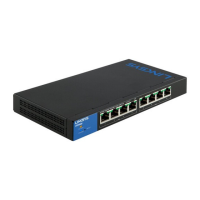56
Table of Contents
Linksys
Multicast registration is the process of listening and responding to Multicast
registration protocols. The available protocols are IGMP for IPv4.
When IGMP snooping is enabled in a device on a VLAN, it analyzes the IGMP
packets it receives from the VLAN connected to the device and Multicast
routers in the network.
When a device learns that a host is using IGMP messages to register to receive
a Multicast stream, optionally from a specific source, the device adds the
registration to its Multicast Forwarding Data Base (MFDB).
• IGMP snooping can effectively reduce Multicast traffic from streaming
bandwidthintensive IP applications. A device using IGMP snooping
only forwards Multicast traffic to the hosts interested in that traffic. This
reduction of Multicast traffic reduces the packet processing at the device,
and also reduces the workload of the end hosts, since they do not have to
receive and filter all of the Multicast traffic generated in the network.
The following versions are supported: IGMP v1/v2/v3.
Multicast Address Properties
Multicast addresses have the following properties:
• Each IPv4 Multicast address is in the address range 224.0.0.0 to
239.255.255.255.
• To map an IP Multicast group address to a Layer 2 Multicast address: for
IPv4, this is mapped by taking the 23 low-order bits from the IPv4 address,
and adding them to the 01:00:5e prefix. By standard, the upper nine bits
of the IP address are ignored, and any IP addresses that only differ in the
value of these upper bits are mapped to the same Layer 2 address, since
the lower 23 bits that are used are identical. For example, 234.129.2.3 is
mapped to a MAC Multicast group address 01:00:5e:01:02:03. Up to 32 IP
Multicast group addresses can be mapped to the same Layer 2 address.
Feature Configuration
The Feature Configuration page enables you to configure the Bridge Multicast
filtering status.
By default, all Multicast frames are flooded to all ports of the VLAN. To
selectively forward only to relevant ports and filter (drop) the Multicast on
the rest of the ports, enable Bridge Multicast filtering status in the Feature
Configuration page.
If filtering is enabled, Multicast frames are forwarded to a subset of the ports in
the relevant VLAN as defined in the Multicast Forwarding Data Base. Multicast
filtering is enforced on all traffic. By default, such traffic is flooded to all relevant
ports, but you can limit forwarding to a smaller subset.
A common way of representing Multicast membership is the (S,G) notation
where S is the (single) source sending a Multicast stream of data, and G is the
IPv4 group address. If a Multicast client can receive Multicast traffic from any
source of a specific Multicast group, this is saved as (*,G).
The following are ways of forwarding Multicast frames:
• MAC Group Address—Based on the destination MAC address in the
Ethernet frame.
NOTE:
One or more IP Multicast group addresses can be mapped to a MAC group
address. Forwarding, based on the MAC group address, can result in an IP
Multicast stream being forwarded to ports that have no receiver for the stream.
• IP Group Address—Based on the destination IP address of the IP packet
(*,G).
• Source Specific IP Group Address—Based on both the destination IP
address and the source IP address of the IP packet (S,G).
By selecting the forwarding mode, you can define the method used by hardware
to identify Multicast flow by one of the following options: MAC Group Address,
IP Group Address, or Source Specific IP Group Address. (S,G) is supported by
IGMPv3, while IGMPv1/2 support only (*.G), which is just the group ID. The device
supports a maximum of 256 static and dynamic Multicast group addresses. To
enable Multicast filtering, and select the forwarding method:
STEP 1 Click Configuration > Multicast > Feature Configuration.
STEP 2 Enter the global parameter:
• Bridge Multicast Filtering—Select to enable filtering of Multicast addresses.
VLAN Settings
• VLAN ID—Select the VLAN ID to set its forwarding method.
• IPv4 Multicast Forwarding—Select one of the following options:
• By MAC Address—Select to enable the MAC address method for
forwarding Multicast packets.

